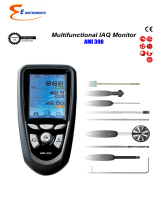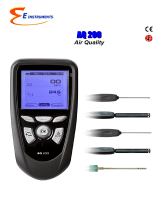Table of contents
1. PRESENTATION............................................................................................................................................................5
1.1 . Instrument description.........................................................................................................................................5
1.2 . Keys description...................................................................................................................................................5
1.3 . Remove battery...................................................................................................................................................6
1.4 . Directive 2014/53/EU..........................................................................................................................................6
2. CONNECTIONS OF THE TM 210....................................................................................................................................7
2.1 . Main features......................................................................................................................................................7
2.2 . Connections........................................................................................................................................................ 7
3. INFORMATION............................................................................................................................................................. 9
4. SET THE INSTRUMENT................................................................................................................................................ 10
4.1 . Set language.....................................................................................................................................................10
4.2 . Set date and time..............................................................................................................................................10
4.3 . Activate or deactivate the beep key....................................................................................................................10
4.4 . Set auto-off.......................................................................................................................................................10
4.5 . Set backlight..................................................................................................................................................... 11
4.6 . Set security........................................................................................................................................................ 11
4.7 . Set code............................................................................................................................................................11
4.8 . Set printing.......................................................................................................................................................11
5. SET THE PROBES........................................................................................................................................................ 12
5.1 . Use of the wire probes and modules..................................................................................................................12
5.2 . Use of wireless probes......................................................................................................................................13
6. CHANNEL CONFIGURATION.......................................................................................................................................14
6.1 . Delta T.............................................................................................................................................................. 14
7. U COEFFICIENT..........................................................................................................................................................15
8. START AND RECORD DATASETS..................................................................................................................................16
8.1 . Start and record datasets...................................................................................................................................16
8.1.1 Manual dataset..........................................................................................................................................16
8.1.2 Automatic dataset...................................................................................................................................... 16
8.1.3 View the recorded datasets.........................................................................................................................17
8.2 . Launch and save averages.................................................................................................................................17
8.2.1 Point/Point average.....................................................................................................................................17
8.2.2 Automatic average......................................................................................................................................18
8.2.3 Automatic Point/Point average....................................................................................................................18
8.3 . Hold-Min./Max..................................................................................................................................................19
9. SETTING OF MEASUREMENT PARAMETERS................................................................................................................20
9.1 . Thermocouple and Pt100...................................................................................................................................20
9.1.1 Unit............................................................................................................................................................ 20
9.1.2 Type (only for thermocouple).......................................................................................................................20
9.1.3 Alarm.........................................................................................................................................................20
9.2 . U coefcient module..........................................................................................................................................20
9.2.1 Unit............................................................................................................................................................ 20
9.2.2 Alarm.........................................................................................................................................................20





















